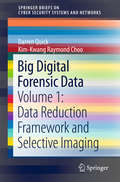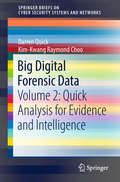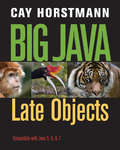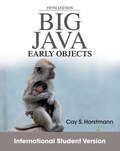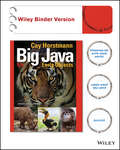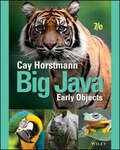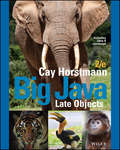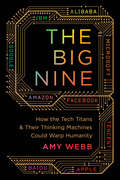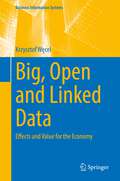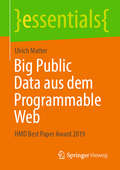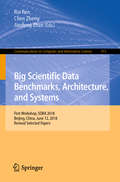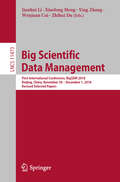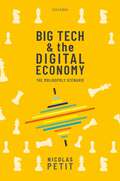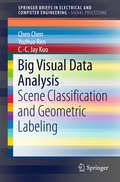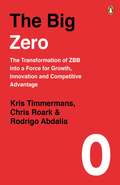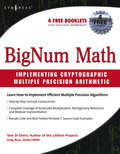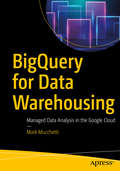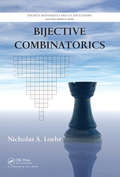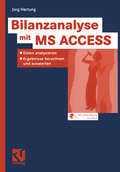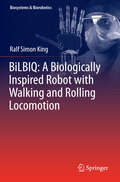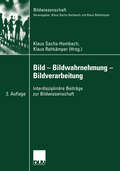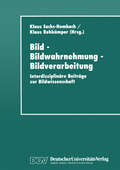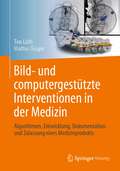- Table View
- List View
Big Digital Forensic Data: Volume 1: Data Reduction Framework and Selective Imaging (SpringerBriefs on Cyber Security Systems and Networks)
by Darren Quick Kim-Kwang Raymond ChooThis book provides an in-depth understanding of big data challenges to digital forensic investigations, also known as big digital forensic data. It also develops the basis of using data mining in big forensic data analysis, including data reduction, knowledge management, intelligence, and data mining principles to achieve faster analysis in digital forensic investigations. By collecting and assembling a corpus of test data from a range of devices in the real world, it outlines a process of big data reduction, and evidence and intelligence extraction methods. Further, it includes the experimental results on vast volumes of real digital forensic data. The book is a valuable resource for digital forensic practitioners, researchers in big data, cyber threat hunting and intelligence, data mining and other related areas.
Big Digital Forensic Data: Volume 2: Quick Analysis for Evidence and Intelligence (SpringerBriefs on Cyber Security Systems and Networks)
by Darren Quick Kim-Kwang Raymond ChooThis book provides an in-depth understanding of big data challenges to digital forensic investigations, also known as big digital forensic data. It also develops the basis of using data mining in big forensic data analysis, including data reduction, knowledge management, intelligence, and data mining principles to achieve faster analysis in digital forensic investigations. By collecting and assembling a corpus of test data from a range of devices in the real world, it outlines a process of big digital forensic data analysis for evidence and intelligence. It includes the results of experiments on vast volumes of real digital forensic data. The book is a valuable resource for digital forensic practitioners, researchers in big data, cyber threat hunting and intelligence, data mining and other related areas.
Big Java: Late Objects
by Cay S. HorstmannBig Java: Late Objects is a comprehensive introduction to Java and computer programming, which focuses on the principles of programming, software engineering, and effective learning. It is designed for a two-semester first course in programming for computer science students.
Big Java: Early Objects
by Cay S. HorstmannThis book introduces programmers to objects at a gradual pace. Optional example modules are included using Alice and Greenfoot. The examples feature annotations with dos and don'ts along with cross references to more detailed explanations in the text. New tables show a large number of typical and cautionary examples. New programming and review problems are also presented that ensure a broad coverage of topics. Cay will also add sections on problem solving, and a new, more approachable and visual design developed for JfE and BJLO is used.
Big Java: Early Objects
by Cay S. HorstmannCay Horstmann's sixth edition of Big Java, Early Objects provides an approachable introduction to fundamental programming techniques and design skills, helping students master basic concepts and become competent coders. Updates for the Java 8 software release and additional visual design elements make this student-friendly text even more engaging. The text is known for its realistic programming examples, great quantity and variety of homework assignments, and programming exercises that build student problem-solving abilities. This edition now includes problem solving sections, more example code online, and exercise from Science and Business.
Big Java: Early Objects
by Cay S. HorstmannBig Java: Early Objects, 7th Edition focuses on the essentials of effective learning and is suitable for a two-semester introduction to programming sequence. This text requires no prior programming experience and only a modest amount of high school algebra. Objects and classes from the standard library are used where appropriate in early sections with coverage on object-oriented design starting in Chapter 8. This gradual approach allows students to use objects throughout their study of the core algorithmic topics, without teaching bad habits that must be un-learned later. The second half covers algorithms and data structures at a level suitable for beginning students.
Big Java Late Objects
by Cay S. HorstmannWith Wiley’s Enhanced E-Text, you get all the benefits of a downloadable, reflowable eBook with added resources to make your study time more effective, including: • Code Walkthrough• Video Examples• Code Rearrange Interactivities • Worked Examples • Self-Check ExercisesThe second edition of Big Java, Late Objects provides an approachable introduction to fundamental programming techniques and design skills, helping students master basic concepts and become competent coders. The second edition is thoroughly updated for Java 8, includes new problem solving sections, and more exercises, some from science, engineering, and business. The text is known for its realistic programming examples, great quantity and variety of homework assignments, and programming exercises that build student problem-solving abilities. Additional visual design elements make this student-friendly text even more engaging.
The Big Nine: How the Tech Titans and Their Thinking Machines Could Warp Humanity
by Amy WebbA call-to-arms about the broken nature of artificial intelligence, and the powerful corporations that are turning the human-machine relationship on its head.We like to think that we are in control of the future of "artificial" intelligence. The reality, though, is that we--the everyday people whose data powers AI--aren't actually in control of anything. When, for example, we speak with Alexa, we contribute that data to a system we can't see and have no input into--one largely free from regulation or oversight. The big nine corporations--Amazon, Google, Facebook, Tencent, Baidu, Alibaba, Microsoft, IBM and Apple--are the new gods of AI and are short-changing our futures to reap immediate financial gain. In this book, Amy Webb reveals the pervasive, invisible ways in which the foundations of AI--the people working on the system, their motivations, the technology itself--is broken. Within our lifetimes, AI will, by design, begin to behave unpredictably, thinking and acting in ways which defy human logic. The big nine corporations may be inadvertently building and enabling vast arrays of intelligent systems that don't share our motivations, desires, or hopes for the future of humanity.Much more than a passionate, human-centered call-to-arms, this book delivers a strategy for changing course, and provides a path for liberating us from algorithmic decision-makers and powerful corporations.
Big, Open and Linked Data: Effects and Value for the Economy (Business Information Systems)
by Krzysztof WęcelThis book examines the recent evolution of the concept of data as an economic and managerial phenomenon. The author first describes and discusses open data and then introduces the concept of linked data, with a focus on assets for reuse. Furthermore, he addresses the main challenges of big data. Value is identified as the main incentive for the adoption of linked data; accordingly, the next two chapters study sources of data value from a macroeconomic and micro economic perspective, respectively. This contributes to the systematization of important issues at the crossroads of enterprise data and data sharing: data ownership, personal data, and data privacy. In turn, the book reveals the role of innovation as a main vehicle for creating value by unifying big, open, and linked data. It studies the ways in which value can be created, transferred, and captured in the form of business models, before the closing chapter verifies the data unification model by combining open and linked geographical data with big data from a major telecom company.
Big Public Data aus dem Programmable Web: HMD Best Paper Award 2019 (essentials)
by Ulrich MatterDie Verbreitung des Internets und die zunehmende Digitalisierung in der öffentlichen Verwaltung und Politik haben über die letzten Jahre zu einer starken Zunahme an hochdetaillierten digitalen Datenbeständen über politische Akteure und Prozesse geführt. Diese big public data werden oft über programmatische Schnittstellen (Web APIs; programmable Web) verbreitet, um die Einbettung der Daten in anderen Webanwendungen zu vereinfachen. Die Analyse dieser Daten für wissenschaftliche Zwecke in der politischen Ökonomie und Politologie ist vielversprechend, setzt jedoch die Implementierung einer data pipeline zur Beschaffung und Aufbereitung von Daten aus dem programmable Web voraus. Dieses Buch diskutiert die Chancen und Herausforderungen der praktischen Nutzung dieser Datenbestände für die empirische Forschung und zeigt anhand einer Fallstudie ein mögliches Vorgehen zur systematischen Analyse von big public data aus dem programmable Web auf.
Big Scientific Data Benchmarks, Architecture, and Systems: First Workshop, SDBA 2018, Beijing, China, June 12, 2018, Revised Selected Papers (Communications in Computer and Information Science #911)
by Rui Ren Chen Zheng Jianfeng ZhanThis book constitutes the refereed proceedings of the First Workshop on Big Scientific Data Benchmarks, Architecture, and Systems, SDBA 2018, held in Beijing, China, in June 2018.The 10 revised full papers presented were carefully reviewed and selected from 22 submissions. The papers are organized in topical sections on benchmarking; performance optimization; algorithms; big science data framework.
Big Scientific Data Management: First International Conference, BigSDM 2018, Beijing, China, November 30 – December 1, 2018, Revised Selected Papers (Lecture Notes in Computer Science #11473)
by Jianhui Li Xiaofeng Meng Ying Zhang Wenjuan Cui Zhihui DuThis book constitutes the refereed proceedings of the First International Conference on Big Scientific Data Management, BigSDM 2018, held in Beijing, Greece, in November/December 2018. The 24 full papers presented together with 7 short papers were carefully reviewed and selected from 86 submissions. The topics involved application cases in the big scientific data management, paradigms for enhancing scientific discovery through big data, data management challenges posed by big scientific data, machine learning methods to facilitate scientific discovery, science platforms and storage systems for large scale scientific applications, data cleansing and quality assurance of science data, and data policies.
Big Tech and the Digital Economy: The Moligopoly Scenario
by Nicolas PetitThis book asks a simple question: are the tech giants monopolies? In the current environment of suspicion towards the major technology companies as a result of concerns about their power and influence, it has become commonplace to talk of Google, Facebook, Amazon, Apple, Microsoft, or Netflix as the modern day version of the 19th century trusts. In turn, the tech giants are vilified for a whole range of monopoly harms towards consumers, workers and even the democratic process. In the US and the EU, antitrust, and regulatory reform is on the way. Using economics, business and management science as well legal reasoning, this book offers a new perspective on big tech. It builds a theory of "moligopoly". The theory advances that the tech giants, or at least some of them, coexist both as monopolies and oligopoly firms that compete against each other in an environment of substantial uncertainty and economic dynamism. With this, the book assesses ongoing antitrust and regulatory policy efforts. It demonstrates that it is counterproductive to pursue policies that introduce more rivalry in moligopoly markets subject to technological discontinuities. And that non-economic harms like privacy violations, fake news, or hate speech are difficult issues that belong to the realm of regulation, not antimonopoly remediation.
Big Tech and the Digital Economy: The Moligopoly Scenario
by Nicolas PetitThis book asks a simple question: are the tech giants monopolies? In the current environment of suspicion towards the major technology companies as a result of concerns about their power and influence, it has become commonplace to talk of Google, Facebook, Amazon, Apple, Microsoft, or Netflix as the modern day version of the 19th century trusts. In turn, the tech giants are vilified for a whole range of monopoly harms towards consumers, workers and even the democratic process. In the US and the EU, antitrust, and regulatory reform is on the way. Using economics, business and management science as well legal reasoning, this book offers a new perspective on big tech. It builds a theory of "moligopoly". The theory advances that the tech giants, or at least some of them, coexist both as monopolies and oligopoly firms that compete against each other in an environment of substantial uncertainty and economic dynamism. With this, the book assesses ongoing antitrust and regulatory policy efforts. It demonstrates that it is counterproductive to pursue policies that introduce more rivalry in moligopoly markets subject to technological discontinuities. And that non-economic harms like privacy violations, fake news, or hate speech are difficult issues that belong to the realm of regulation, not antimonopoly remediation.
Big Visual Data Analysis: Scene Classification and Geometric Labeling (SpringerBriefs in Electrical and Computer Engineering)
by Chen Chen Yuzhuo Ren C.-C. Jay KuoThis book offers an overview of traditional big visual data analysis approaches and provides state-of-the-art solutions for several scene comprehension problems, indoor/outdoor classification, outdoor scene classification, and outdoor scene layout estimation. It is illustrated with numerous natural and synthetic color images, and extensive statistical analysis is provided to help readers visualize big visual data distribution and the associated problems. Although there has been some research on big visual data analysis, little work has been published on big image data distribution analysis using the modern statistical approach described in this book. By presenting a complete methodology on big visual data analysis with three illustrative scene comprehension problems, it provides a generic framework that can be applied to other big visual data analysis tasks.
The Big Zero: The Transformation of ZBB into a Force for Growth, Innovation and Competitive Advantage
by Kris Timmermans Chris Roark Rodrigo AbdallaDo you want to achieve startup speed at enterprise scale? Growth. It's what every company strives for. But it's become more and more elusive as companies struggle to hit their projected growth rates in an increasingly competitive market. While zero-based budgeting (ZBB) has been wielded for decades to cut costs, it falls short when it comes to spurring growth. But a zero-based mindset (ZBx) does that and more. ZBx facilitates forensic oversight into resource allocation that funnels savings back into growth initiatives and encourages new sources of innovation. The Big Zero shows how a ZBx approach focuses on agility over austerity, visibility over guesswork and the future over the past to fuel growth and competitiveness.
BigNum Math: Implementing Cryptographic Multiple Precision Arithmetic
by Tom St DenisImplementing cryptography requires integers of significant magnitude to resist cryptanalytic attacks. Modern programming languages only provide support for integers which are relatively small and single precision. The purpose of this text is to instruct the reader regarding how to implement efficient multiple precision algorithms.Bignum math is the backbone of modern computer security algorithms. It is the ability to work with hundred-digit numbers efficiently using techniques that are both elegant and occasionally bizarre. This book introduces the reader to the concept of bignum algorithms and proceeds to build an entire library of functionality from the ground up. Through the use of theory, pseudo-code and actual fielded C source code the book explains each and every algorithm that goes into a modern bignum library. Excellent for the student as a learning tool and practitioner as a reference alike BigNum Math is for anyone with a background in computer science who has taken introductory level mathematic courses. The text is for students learning mathematics and cryptography as well as the practioner who needs a reference for any of the algorithms documented within.* Complete coverage of Karatsuba Multiplication, the Barrett Algorithm, Toom-Cook 3-Way Multiplication, and More * Tom St Denis is the developer of the industry standard cryptographic suite of tools called LibTom. * This book provides step-by-step exercises to enforce concepts
BigQuery for Data Warehousing: Managed Data Analysis in the Google Cloud
by Mark MucchettiCreate a data warehouse, complete with reporting and dashboards using Google’s BigQuery technology. This book takes you from the basic concepts of data warehousing through the design, build, load, and maintenance phases. You will build capabilities to capture data from the operational environment, and then mine and analyze that data for insight into making your business more successful. You will gain practical knowledge about how to use BigQuery to solve data challenges in your organization.BigQuery is a managed cloud platform from Google that provides enterprise data warehousing and reporting capabilities. Part I of this book shows you how to design and provision a data warehouse in the BigQuery platform. Part II teaches you how to load and stream your operational data into the warehouse to make it ready for analysis and reporting. Parts III and IV cover querying and maintaining, helping you keep your information relevant with other Google Cloud Platform services and advanced BigQuery. Part V takes reporting to the next level by showing you how to create dashboards to provide at-a-glance visual representations of your business situation. Part VI provides an introduction to data science with BigQuery, covering machine learning and Jupyter notebooks.What You Will LearnDesign a data warehouse for your project or organizationLoad data from a variety of external and internal sourcesIntegrate other Google Cloud Platform services for more complex workflowsMaintain and scale your data warehouse as your organization growsAnalyze, report, and create dashboards on the information in the warehouseBecome familiar with machine learning techniques using BigQuery MLWho This Book Is ForDevelopers who want to provide business users with fast, reliable, and insightful analysis from operational data, and data analysts interested in a cloud-based solution that avoids the pain of provisioning their own servers.
Bijective Combinatorics (Discrete Mathematics And Its Applications Ser.)
by Nicholas LoehrBijective proofs are some of the most elegant and powerful techniques in all of mathematics. Suitable for readers without prior background in algebra or combinatorics, Bijective Combinatorics presents a general introduction to enumerative and algebraic combinatorics that emphasizes bijective methods.The text systematically develops the mathematical
Bilanzanalyse mit MS ACCESS: Daten analysieren, Ergebnisse berechnen und auswerten
by Jörg HartungEine effektive Einarbeitung in die Bilanzanalyse und Unternehmensbewertung mit Hilfe von MS ACCESS. Sie lernen an einem Musterbeispiel vorliegende Jahresabschlussdaten aufzubereiten und die notwendigen Kennzahlen zu berechnen. So kommen Sie zu einer realistischen Beurteilung der wirtschaftlichen Lage Ihres Unternehmens. Die vorgelegten Musterauswertungen können Sie unmittelbar in Ihre betriebliche Praxis übertragen. Jedes Kapitel ist so erläutert, dass der Leser die einzelnen Arbeitsschritte leicht nachvollziehen und die Abschlüsse selbstständig analysieren lernt. Für den Leser gibt es online einen kostenlosen Aktualisierungsservice.
BiLBIQ: A Biologically Inspired Robot with Walking and Rolling Locomotion (Biosystems & Biorobotics)
by Ralf Simon KingThe book ‘BiLBIQ: A biologically inspired Robot with walking and rolling locomotion’ deals with implementing a locomotion behavior observed in the biological archetype Cebrennus villosus to a robot prototype whose structural design needs to be developed. The biological sample is investigated as far as possible and compared to other evolutional solutions within the framework of nature’s inventions. Current achievements in robotics are examined and evaluated for their relation and relevance to the robot prototype in question. An overview of what is state of the art in actuation ensures the choice of the hardware available and most suitable for this project. Through a constant consideration of the achievement of two fundamentally different ways of locomotion with one and the same structure, a robot design is developed and constructed taking hardware constraints into account. The development of a special leg structure that needs to resemble and replace body elements of the biological archetype is a special challenge to be dealt with. Finally a robot prototype was achieved, which is able to walk and roll - inspired by the spider Cebrennus villosus.
Bild — Bildwahrnehmung — Bildverarbeitung: Interdisziplinäre Beiträge zur Bildwissenschaft (Bildwissenschaft #15)
by Klaus Sachs-Hombach Klaus RehkämperBildgegebende Verfahren sind heute zu einem unverzichtbaren Bestandteil der technischen Konstruktion wie der wissenschaftlichen Analyse geworden, denn sie ermöglichen, komplexe Sachverhalte zu vereinfachen und zu strukturieren. Eine Bildwissenschaft hat sich aber bisher kaum ausgebildet. Klaus Sachs-Hombach und Klaus Rehkämper stellen die Ergebnisse einer interdisziplinären Zusammenarbeit vor, um das entstehen einer allgemeinen Bildwissenschaft zu fördern.
Bild - Bildwahrnehmung - Bildverarbeitung: Interdisziplinäre Beiträge zur Bildwissenschaft
by Klaus Sachs-Hombach Klaus RehkämperEine Bildwissenschaft hat sich bisher kaum ausgebildet. Dieser Band stellt die Ergebnisse einer interdisziplinären Zusammenarbeit vor, um das Entstehen einer allgemeinen Bildwissenschaft zu fördern.
Bild- und computergestützte Interventionen in der Medizin: Algorithmen, Entwicklung, Dokumentation und Zulassung eines Medizinprodukts
by Tim Christian Lüth Mattias Felix TrägerDieses Buch richtet sich an Ingenieure, Informatiker sowie interessierte Angehörige der medizinischen und pflegerischen Berufe. Es erklärt die Grundlagen und Anwendungen der computerassistierten- und robotergestützten Medizingeräte auf dem aktuellen Stand der Technik. Derartige Systeme haben in den letzten 20 Jahren revolutionäre positive Veränderungen in der Radiologie, bei Interventionen und in vielen Gebieten der Chirurgie bewirkt. Mit dieser Technik ist es möglich, Bilddaten aus unterschiedlichen bildgebenden Systemen – wie z.B. Computertomograph, Ultraschall-gerät oder Videoendoskop – zu fusionieren, am Bildschirm dreidimensional darzustellen und darin mit dem Computer Eingriffe zu planen. Während der Operation wird die räumliche Lage des navigierten Instruments gemessen und im 3D-Modell des Patienten am Bildschirm dargestellt. Geplante Pfade der Instrumente werden eingeblendet, es wird vor Risiken bei Abweichungen von der Planung gewarnt und es können aktive Instrumente wie Bohrer, Fräser, Laser oder sogar Roboter automatisiert gesteuert werden. Die Autoren sind auf diesem Gebiet seit über 25 Jahren sowohl wissenschaftlich als auch unternehmerisch international führend tätig, weshalb in diesem Buch auch Entwicklungsmethodik, Dokumentation, Zulassung und Inverkehrbringung als Medizinprodukt praxisnah erläutert werden.
Bild- und Grafikprojekte: Briefing – Planung – Produktion (Bibliothek der Mediengestaltung)
by Peter Bühler Patrick Schlaich Dominik SinnerDie Bibliothek der Mediengestaltung richtet sich an alle, die eine Ausbildung oder ein Studium im Bereich der Digital- und Printmedien absolvieren oder die bereits in dieser Branche tätig sind und sich fortbilden möchten. Weiterhin richtet sich die Bibliothek der Mediengestaltung auch an alle, die sich in ihrer Freizeit mit der professionellen Gestaltung und Produktion digitaler oder gedruckter Medien beschäftigen.Die Planung, Durchführung und Reflexion von Projekten stellt dabei eine Kernkompetenz der Mediengestaltung dar. In Projekten lassen sich nicht nur die theoretischen Kenntnisse an Praxisbeispielen anwenden – die Lernenden erweitern hierdurch auch ihre Methoden-, Sozial- und Personalkompetenz.Dieser Band aus der Bibliothek der Mediengestaltung behandelt die Konzeption und Produktion folgender Bild- und Grafikprojekte:Nondestruktives ArbeitenBilddateienFarbmanagementFreistellenBildkorrekturenBildretuscheFotocollageFotocomposingFotografie – BewegungFotografie – Figur-Grund-TrennungGrafikKurzanleitungDiagrammLogoPiktogrammsystemVektorisierenDie vier Projektebände dieser Buchreihe verfolgen das Ziel, einen Praxis- und Anwendungsbezug zu den eher theoretisch ausgerichteten 26 Einzelbänden der „Bibliothek der Mediengestaltung“ herzustellen.Jedes Kapitel ist identisch aufgebaut und gliedert sich in Briefing, Planung und Produktion des jeweiligen Projektes. Die Umsetzung der Projekte kann anhand von Schritt-für-Schritt-Anleitungen problemlos nachvollzogen werden. Sämtliche Dateien, die für das Projekt erforderlich sind, können auf bi-me.de heruntergeladen werden.
